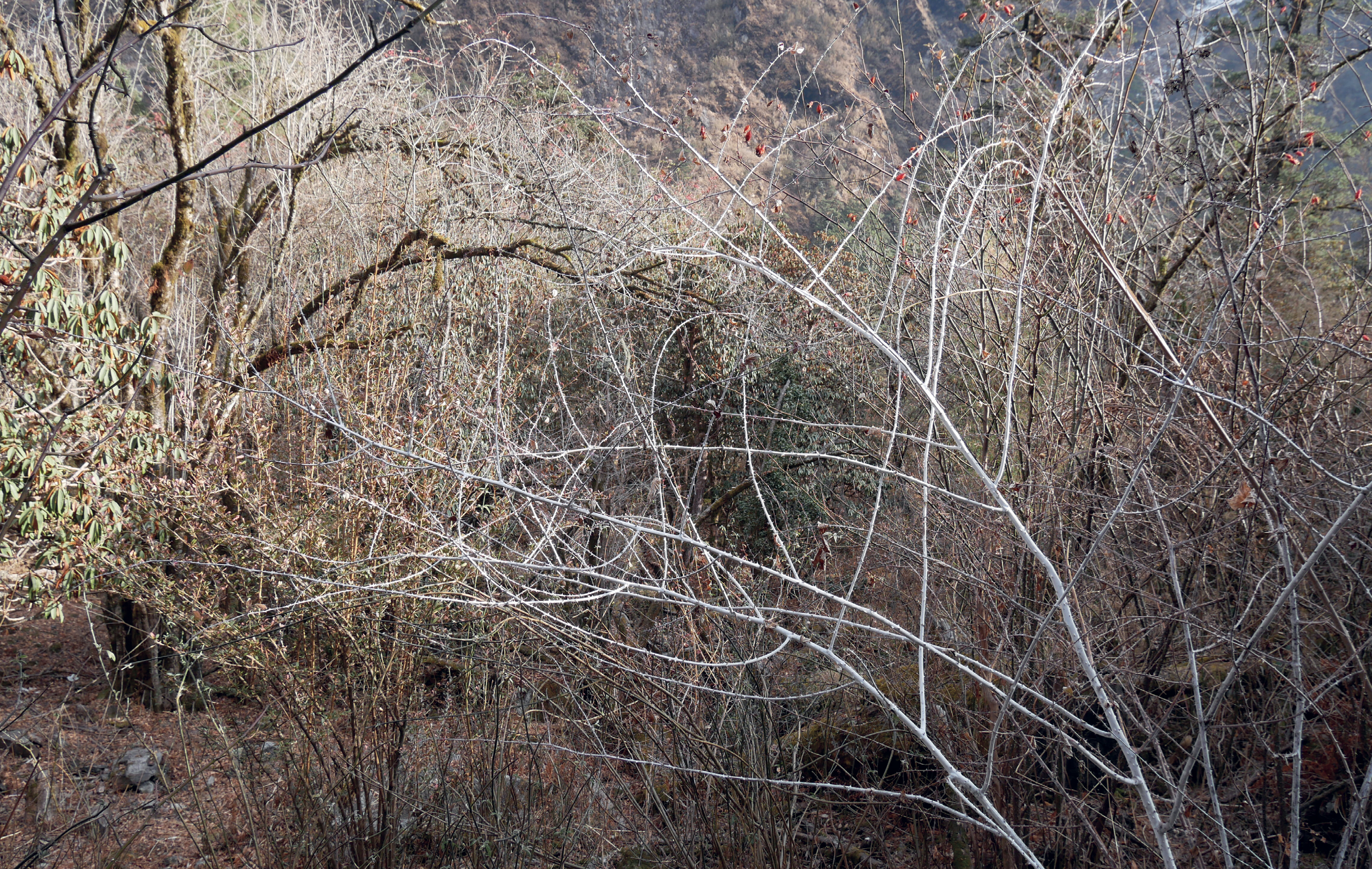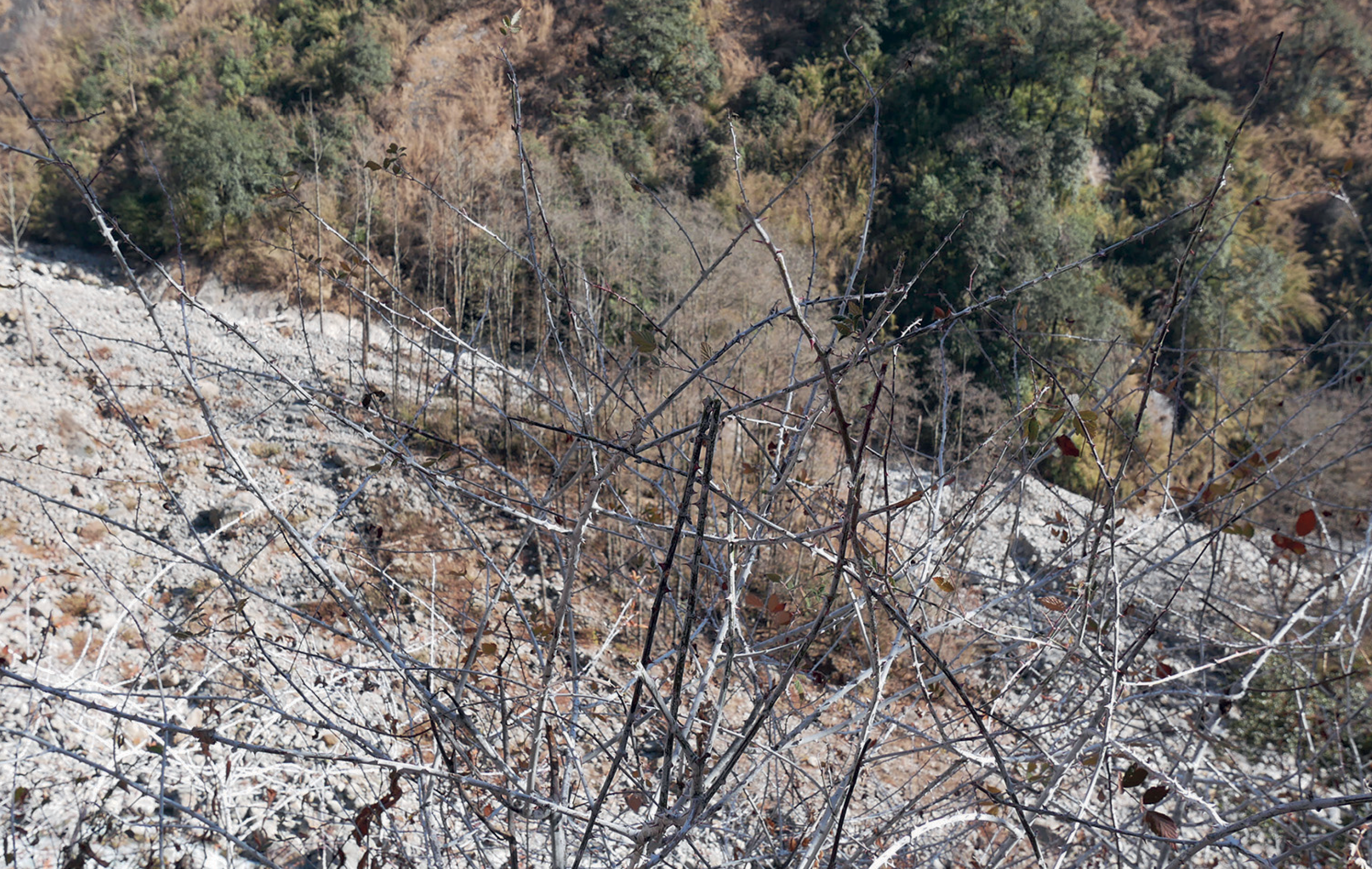Along the way, it is not difficult to imagine how reconstruction aggravated systemic inequalities and created opportunities for both increased foreign influence and the marginalization of villagers. Running alongside these realities is the fact that following the earthquake, aid programs quickly shifted towards capital-intensive infrastructure, from roads to hospitals, manipulated by competition between major donors, all eager to commit billions to the reconstruction process. Aid presents a complex topography in relation
to reconstruction when there is nothing to build back. The pivot to large infrastructure is not aid if it cannot reach villagers stranded at high altitude. The structure of humanitarianism is simply not agile enough to support remote reconstruction when the most basic building materials must be carried for days on foot, across backs and strapped to mules, along paths vulnerable to further landslides and monsoon rains.
The eagerness to provide relief through capital is exposed by its motivations: half the funds took the form of loans, further sinking the Nepali Government into public debt.
Shradha Ghale is a Nepali author and relief organizer who summarised her experience directly following the events. Her words resonate deeply to this day:
Understanding the causes and consequences of these hierarchies is critical to recentring local knowledge, practice, and concern. Prior to the walk to Langtang, I had the extraordinary opportunity of meeting with Dr. George Varughese and Mohan Das Manandhar from the Niti Foundation in Kathmandu. It was our second meeting; our paths had crossed at a Humanitarian Design Conference I led shortly after the earthquake in Cambridge, Massachusetts. George
is fiercely passionate with a generous intellect; he understands how the confluence of aid and relief work all-too-often disregards local knowledge, concern, and capacity. Mohan is a reflective individual, who usually nods while George is energetically recounting the failures of legislation to act inclusively and the efforts of Niti to grow a unique- ly Nepali owned and operated NGO. Together, they seek funding to educate women, teach English, and “reimagine” development. When I described the respect for land deeply imparted by retreat, and connected policies that enable landless citizens, they agreed quickly. I found myself defending the land, speaking for how the land itself was left out of recovery processes, and then Mohan saved me. He simply said:
But the loudness is not limited to Nepal. A vast region that makes up the Himalayas including all of Nepal, and parts of Afghanistan, Bangladesh, Bhutan, China, India, Pakistan, and Tajikistan is often called the “third pole.”
to reconstruction when there is nothing to build back. The pivot to large infrastructure is not aid if it cannot reach villagers stranded at high altitude. The structure of humanitarianism is simply not agile enough to support remote reconstruction when the most basic building materials must be carried for days on foot, across backs and strapped to mules, along paths vulnerable to further landslides and monsoon rains.
The eagerness to provide relief through capital is exposed by its motivations: half the funds took the form of loans, further sinking the Nepali Government into public debt.
13
Alex Copping et al., “Understanding
Material and Supplier Networks in the
Construction of Disaster-Relief Shelters: The
Feasibility of Using Social Network Analysis
as a Decision-Making Tool,” Journal of
Humanitarian Logistics and Supply Chain
Management 12.1 (2022): 78–105.
The failure of reconstruction and supply networks exposed the colonizing power of international aid agencies, their closed doors, international staff, and inability to keep up with events outside the capital. Nepal is a country pulled apart by geo-political interests that use land policy as a form of social and economic aid, without paying attention to a unique seismically active and glacially endowed landscape.Shradha Ghale is a Nepali author and relief organizer who summarised her experience directly following the events. Her words resonate deeply to this day:
In every affected village I visited, I met young people like Ashok [Tamang] who had played an indispensable role in ensuring their communities’ survival in the aftermath of the earthquake. Youth who had been working in extremely challenging conditions, despite personal losses, amid immense physical risks, without any material reward. They have intimate knowledge of their place and people and tremendous potential to bring change in their villages. But they have little formal education, cannot speak English, and have no access to networks of power in Kathmandu. This leaves them with very few avenues of personal development. Those fortunate enough to get an NGO job are usually at the bottom of the aid system’s hierarchy, a mere “local” with no authority to shape the organisation’s programmes and policies.14Shradha Ghale, “The Deeper Catastrophe,” in House of Snow, eds. Ranulph Fiennes and Ed Douglas (London: Head of Zeus, 2016), 542–43.
Understanding the causes and consequences of these hierarchies is critical to recentring local knowledge, practice, and concern. Prior to the walk to Langtang, I had the extraordinary opportunity of meeting with Dr. George Varughese and Mohan Das Manandhar from the Niti Foundation in Kathmandu. It was our second meeting; our paths had crossed at a Humanitarian Design Conference I led shortly after the earthquake in Cambridge, Massachusetts. George
is fiercely passionate with a generous intellect; he understands how the confluence of aid and relief work all-too-often disregards local knowledge, concern, and capacity. Mohan is a reflective individual, who usually nods while George is energetically recounting the failures of legislation to act inclusively and the efforts of Niti to grow a unique- ly Nepali owned and operated NGO. Together, they seek funding to educate women, teach English, and “reimagine” development. When I described the respect for land deeply imparted by retreat, and connected policies that enable landless citizens, they agreed quickly. I found myself defending the land, speaking for how the land itself was left out of recovery processes, and then Mohan saved me. He simply said:
“The land is loud in Nepal.”
But the loudness is not limited to Nepal. A vast region that makes up the Himalayas including all of Nepal, and parts of Afghanistan, Bangladesh, Bhutan, China, India, Pakistan, and Tajikistan is often called the “third pole.”
15
The expression was first used by the
Swiss geographer, mountaineer, and explorer
Marcel Kurz in 1933. See Günter Oskar
Dyhrenfurth, To the Third Pole: The History of
the High Himalaya (London: W. Laurie, 1955).
It is not hard to imagine why: this region of high-mountain plateaus is a freshwater bank. It thrives in the drama of uncertainty between freeze and thaw, since it stores the third largest ice mass. It hosts glacier headwaters. When Mohan told us that the land was loud, he was not speaking metaphorically. The rocks clang, smash and roar—ice squeaks and shuffles, and usually the sounds are made in the thickness of difference between the vast below ground and the temperature of the atmosphere. In a time of extreme climate change; the land is, in fact, getting louder.
At roughly six hundred metres, the winter garden in Langtang with Rosa macroohylla (jangali gulab) in the foreground. Each plant was a pleasurable mystery to identify upon returning from Nepal, and I relied significantly on Manandhar's Plants and People of Nepal, with all Nepali names borrowed from his research.
On Collecting & Hunting
My fierce love of plants is challenged by my understanding of the vi- olence of plant hunters. Thus, it is worth repeating that Nepal is legendary in horticultural traditions in that it stands out as a land where new species are readily “discovered.” Here “new” means otherwise unnamed by Euro-Western botanical scholarship or the gardening trade. My love of plants often brings me back to those authors that write about gardening, because gardens are the most obvious form to care for the living world in ways that unite species. In this respect, Kincaid is a beloved reference, as she seamlessly accepts that her love of garden plants does not conflict with her personal examinations of colonial habits. (She also gardens in Vermont, as I do).
Kincaid deftly expresses gratitude for the plant hunters responsible for amassing and distributing some of her most beloved plants, and it is her desire to join an expedition and relive the intimacy of seed collecting. The novelty of plant hunting is embedded in the prosperity of Nepali flora, following in the footsteps of Nathaniel Wallich, William Roxburgh, Joseph Dalton Hooker, and Ernest Wilson, some of the most famous plant hunters that “discovered”Aconitum, Clematis, Magnolia, and most of the thirty or so Rhododendron species, intro- ducing these plants to the gardening world.
“The plant hunters were descendants of people and ideas that used to hunt me.”
16
Kincaid, Among Flowers, 12.
— Jamaica Kincaid, Among Flowers
In 2002, ethnobotanist Narayan P. Manandhar published The Plants and People of Nepal, a culmination of his thirty-year collecting career. Manandhar collected on-foot to acquire knowledge and to compile a resource, a counterpoint to the dwindling familiarity with medicinal plants in Nepal. The book is encyclopaedic in its documentation of 1,517 taxa belonging to 858 genera and 195 families, including 1,434 flowering plants, 65 pteridophytes, and 18 gymnosperms. He reports and describes 800 species for ethnomedicine, 440 used
as wild food plants, and about 80 used for horticultural cultivation. For three decades, Manandhar lugged around a portable herbarium; to collect, number, press, dry, label, and remark upon the relationship between plants and people. In the introduction, he describes the difficulty of sleeping in the open, or looking for homes that might welcome them, as it was too hard to also carry tents along with all their botanical supplies. But a botanic collection alone cannot identify the customs inherent in the plants, or the relationships embedded over time.

